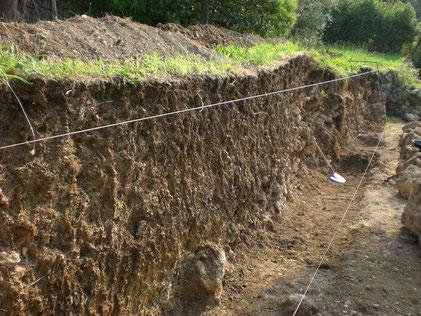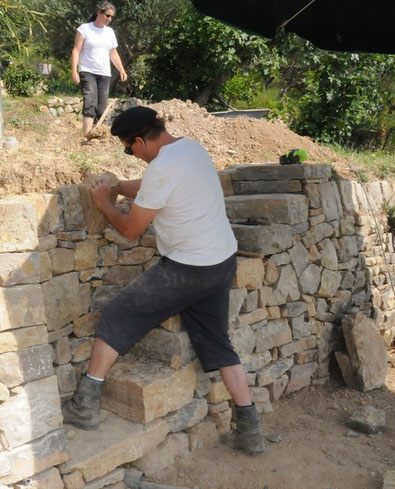Dry Stone Wall restoration in le Var (South East of France)
The technique of “dry stone” construction consists in assembling stones with no mortar, water is not necessary, hence the name… dry stone. This millennium technique is very present in Provence.
In the bend of a path, maybe you will fall upon a “borie” (a dry stone hut using the vault technique as in corbelled construction), a “restanque”
(a dry stone wall), an “apiès” (a niche with bee hive), a well…which are real works of art lost in the middle of nowhere. Dry stone walls are very practical because they aid drainage and prevent the erosion of the ground. They also have the ability to store heat from the sun in the daytime and restore it during the night. We restore and create every type of stone buildings in dry stone.
Dry stone wall restoration (assembly with dry joints)
in Cotignac (83)
A small commentary dedicated to Emmanuel Six. By TF1 news at 13h during « les Journées des Métiers d'Art».
Made during this stone wall restoration.
(31st March 2011)

Dry stone wall restoration (called locally restanque)
in Flassans (Var 83)
Dry stone wall restoration
in Entrecasteaux (Var 83)
Old dry stone wall restoration
in Tourtour (Var 83)
Dry stone wall repair
in Magagnosc (Alpes-Maritimes 06)
Rebuilding a damaged dry stone wall
(in le Coeur du Var 83)
Type of rock : hard limestone (natural in our area).
Old dry stone wall restoration
in Salernes (Var 83)
Renovation of an another type of dry stone wall
Type of rock : sandstone.
Construction of Dry Stone Walls
in les Issambres (Var 83)
Construction of a Dry Stone Wall
in Lorgues (Var 83)
Construction of a "Calade"
in Fréjus (Var 83)

"Rue en calade" describes a road with a surface composed in this way — essentially a cobblestone road. These are found predominantly in the French region of Provence, and generally in the Mediterranean area.
Dry stone wall and staircase restoration
Dry stone staircase restoration and reorganisation
in Cotignac (Var 83)
Dry stone staircase in le Var (83)
(perpendicular to the wall)
Staircase in a dry stone wall
in Draguignan (Var 83)
Steps and the wall are made of the same stone.
Do not hesitate to ask us for a free estimate or for further information.
We signed up to the national charter of dry stone masons which adhere to the following principles :
= > to bring the technical solutions to insure the stability of grounds which are essential in landscape and water management.
= > global approach of sustainable development.
= > protect dry stone works.
= > insure an environmentally-friendly stone supply.
= > apply the rules of craftsmanship corresponding to the constructions of dry stone breast walls.









































